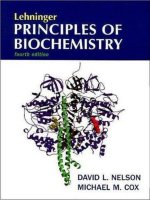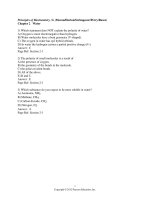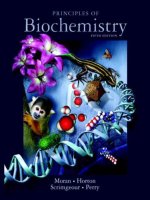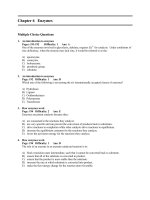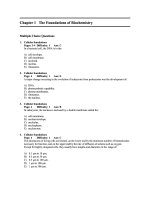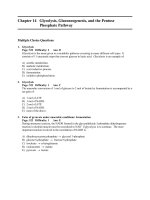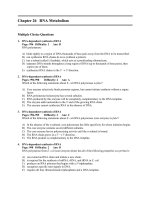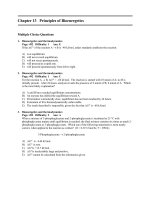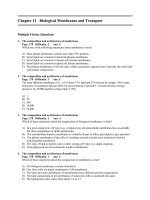kupdf com lehninger principles of biochemistry test bank ch 26pdf
Bạn đang xem bản rút gọn của tài liệu. Xem và tải ngay bản đầy đủ của tài liệu tại đây (209.01 KB, 12 trang )
Chapter 26 RNA Metabolism
Multiple Choice Questions
1. DNA-dependent synthesis of RNA
Page: 996 Difficulty: 2 Ans: B
RNA polymerase:
A)
B)
C)
D)
binds tightly to a region of DNA thousands of base pairs away from the DNA to be transcribed.
can synthesize RNA chains de novo (without a primer).
has a subunit called λ (lambda), which acts as a proofreading ribonuclease.
separates DNA strands throughout a long region of DNA (up to thousands of base pairs), then
copies one of them.
E) synthesizes RNA chains in the 3' → 5' direction.
2. DNA-dependent synthesis of RNA
Pages: 996-998
Difficulty: 2 Ans: A
Which of the following statements about E. coli RNA polymerase is false?
A) Core enzyme selectively binds promoter regions, but cannot initiate synthesis without a sigma
factor.
B) RNA polymerase holoenzyme has several subunits.
C) RNA produced by this enzyme will be completely complementary to the DNA template.
D) The enzyme adds nucleotides to the 3' end of the growing RNA chain.
E) The enzyme cannot synthesize RNA in the absence of DNA.
3. DNA-dependent synthesis of RNA
Pages: 996-999
Difficulty: 2 Ans: C
Which of the following statements about E. coli RNA polymerase (core enzyme) is false?
A)
B)
C)
D)
E)
In the absence of the σ subunit, core polymerase has little specificity for where initiation begins.
The core enzyme contains several different subunits.
The core enzyme has no polymerizing activity until the σ subunit is bound.
The RNA chain grows in a 5' → 3' direction.
The RNA product is complementary to the DNA template.
4. DNA-dependent synthesis of RNA
Page: 998 Difficulty: 2 Ans: D
RNA polymerase from E. coli (core enzyme alone) has all of the following properties except that it:
A)
B)
C)
D)
E)
can extend an RNA chain and initiate a new chain.
is required for the synthesis of mRNA, rRNA, and tRNA in E. coli.
produces an RNA polymer that begins with a 5'-triphosphate.
recognizes specific start signals in DNA.
requires all four ribonucleoside triphosphates and a DNA template.
302
Chapter 26 RNA Metabolism
5. DNA-dependent synthesis of RNA
Page: 998 Difficulty: 2 Ans: B
The sigma factor of E. coli RNA polymerase:
A)
B)
C)
D)
E)
associates with the promoter before binding core enzyme.
combines with the core enzyme to confer specific binding to a promoter.
is inseparable from the core enzyme.
is required for termination of an RNA chain.
will catalyze synthesis of RNA from both DNA template strands in the absence of the core
enzyme.
6. DNA-dependent synthesis of RNA
Pages: 999-1001 Difficulty: 2 Ans: B
After binding by E. coli RNA polymerase, the correct order of events for transcription initiation is:
A)
B)
C)
D)
E)
closed complex formation, open complex formation, promoter clearance, start of RNA synthesis.
closed complex formation, open complex formation, start of RNA synthesis, promoter clearance.
open complex formation, closed complex formation, start of RNA synthesis, promoter clearance.
start of RNA synthesis, closed complex formation, open complex formation, promoter clearance.
start of RNA synthesis, open complex formation, closed complex formation, promoter clearance.
7. DNA-dependent synthesis of RNA
Pages: 1000-1001 Difficulty: 2 Ans: B
Which one of the following statements about E. coli RNA polymerase (core enzyme) is false?
A)
B)
C)
D)
E)
It can start new chains de novo or elongate old ones.
It has no catalytic activity unless the sigma factor is bound.
It uses nucleoside 5'-triphosphates as substrates.
Its activity is blocked by rifampicin.
Its RNA product will hybridize with the DNA template.
8. DNA-dependent synthesis of RNA
Page: 1002
Difficulty: 2 Ans: E
“Footprinting” or DNase protection is a technique used to identify:
A)
B)
C)
D)
E)
a region of DNA that has been damaged by mutation.
E. coli cells that contain a desired, cloned piece of DNA.
the position of a particular gene of a chromosome.
the position of internally double-stranded regions in a single-stranded DNA molecule.
the specific binding site of a repressor, polymerase, or other protein on the DNA.
9. DNA-dependent synthesis of RNA
Page: 1003
Difficulty: 3 Ans: B
Which one of the following statements about eukaryotic RNA polymerases is correct?
A) All three eukaryotic RNA polymerases recognize the same promoters as prokaryotic
polymerases.
B) None of the eukaryotic RNA polymerases recognizes prokaryotic promoters.
C) Only eukaryotic RNA polymerase I recognizes prokaryotic promoters.
D) Only eukaryotic RNA polymerase II recognizes prokaryotic promoters.
E) Only eukaryotic RNA polymerase III recognizes prokaryotic promoters.
Chapter 26 RNA Metabolism
303
10. DNA-dependent synthesis of RNA
Pages: 1003-1005 Difficulty: 3 Ans: B
Which of the following is not known to be involved in initiation by eukaryotic RNA polymerase II?
A)
B)
C)
D)
E)
DNA helicase activity
DNA polymerase activity
Formation of an open complex
Protein binding to specific DNA sequences
Protein phosphorylation
11. RNA processing
Page: 1007
Difficulty: 1 Ans: B
Processing of a primary mRNA transcript in a eukaryotic cell does not normally involve:
A)
B)
C)
D)
E)
attachment of a long poly(A) sequence at the 3' end.
conversion of normal bases to modified bases, such as inosine and pseudouridine.
excision of intervening sequences (introns).
joining of exons.
methylation of one or more guanine nucleotides at the 5' end.
12. RNA processing
Page: 1008
Difficulty: 2 Ans: C
The 5'-terminal cap structure of eukaryotic mRNAs is a(n):
A)
B)
C)
D)
E)
7-methylcytosine joined to the mRNA via a 2',3'-cyclic linkage.
7-methylguanosine joined to the mRNA via a 5' → 3' diphosphate linkage.
7-methylguanosine joined to the mRNA via a 5' → 5' triphosphate linkage.
N6-methyladenosine joined to the mRNA via a 5' → 5' phosphodiester bond.
O6-methylguanosine joined to the mRNA via a 5' → 5' triphosphate linkage.
13. RNA processing
Page: 1009
Difficulty: 2 Ans: B
The excision (splicing) of many group I introns requires, in addition to the primary transcript RNA:
A)
B)
C)
D)
E)
a cytosine nucleoside or nucleotide and a protein enzyme.
a guanine nucleoside or nucleotide (only).
a protein enzyme only.
a small nuclear RNA and a protein enzyme.
ATP, NAD, and a protein enzyme.
14. RNA processing
Page: 1009
Difficulty: 3 Ans: E
A branched (“lariat”) structure is formed during:
A)
B)
C)
D)
E)
attachment of a 5' cap to mRNA.
attachment of poly(A) tails to mRNA.
processing of preribosomal RNA.
splicing of all classes of introns.
splicing of group II introns.
304
Chapter 26 RNA Metabolism
15. RNA processing
Page: 1010
Difficulty: 2 Ans: E
Splicing of introns in nuclear mRNA primary transcripts requires:
A)
B)
C)
D)
E)
a guanine nucleoside or nucleotide.
endoribonucleases.
polynucleotide phosphorylase.
RNA polymerase II.
small nuclear ribonucleoproteins (snurps).
16. RNA processing
Page: 1013
Difficulty: 2 Ans: B
Which one of the following is not true of the mRNA for ovalbumin?
A)
B)
C)
D)
E)
Exons are used for polypeptide synthesis.
Introns are complementary to their adjacent exons and will form hybrids with them.
The mature mRNA is substantially shorter than the corresponding region on the DNA.
The mRNA is originally synthesized in the nucleus, but ends up in the cytoplasm.
The splicing that yields a mature mRNA occurs at very specific sites in the RNA primary
transcript.
17. RNA processing
Page: 1014
Difficulty: 3 Ans: E
Differential RNA processing may result in:
A)
B)
C)
D)
E)
a shift in the ratio of mRNA produced from two adjacent genes.
attachment of the poly(A) tail to the 5' end of an mRNA.
inversion of certain exons in the final mRNA.
the production of the same protein from two different genes.
the production of two distinct proteins from a single gene.
18. RNA processing
Pages: 1015-1016 Difficulty: 3 Ans: A
Which of the following statements about the synthesis of rRNA and tRNA in E. coli is true?
A)
B)
C)
D)
E)
Both rRNA and some tRNAs are part of the same primary transcript.
Each rRNA sequence (16S, 23S, 5S) is transcribed into a separate primary transcript.
Primary tRNA transcripts undergo methylation, but rRNA sequences are not methylated.
The tRNA sequences all lie at the 3’end of the rRNA transcripts
There is a single copy of the rRNA genes.
19. RNA processing
Pages: 1018-1019 Difficulty: 2 Ans: C
Which of the following is not usually essential for the catalytic activity of ribozymes?
A)
B)
C)
D)
E)
Correct base pairing
Correct base sequence
Correct interaction with protein
Correct secondary structure
Correct three-dimensional structure
Chapter 26 RNA Metabolism
305
20. RNA processing
Page: 1019
Difficulty: 2 Ans: D
Which one of the following properties of the L-19 IVS ribozyme is not shared with enzymes that are
purely protein?
A)
B)
C)
D)
E)
It acts as a true catalyst.
It can be competitively inhibited.
It displays Michaelis-Menten kinetics.
It exploits base-pairing with internal guide sequences.
It makes use of covalent and metal ion catalysis.
21. RNA processing
Page: 1020
Difficulty: 3 Ans: E
Which one of the following statements about mRNA stability is true?
A)
B)
C)
D)
E)
Degradation always proceeds in the 5' to 3' direction.
Degradation of mRNA by polynucleotide phosphorylase yields 5'-nucleoside monophosphates.
In general, bacterial mRNAs have longer half-lives than do eukaryotic mRNAs.
Rates of mRNA degradation ared always at least 10-fold slower than rates of mRNA synthesis.
Secondary structure in mRNA (hairpins, for example) slows the rate of degradation.
22. RNA-dependent synthesis of RNA and DNA
Page: 1021
Difficulty: 2 Ans: A
The reverse transcriptase of an animal RNA virus catalyzes:
A)
B)
C)
D)
E)
degradation of the RNA strand in a DNA-RNA hybrid.
insertion of the viral genome into a chromosome of the host (animal) cell.
RNA formation in the 3' → 5' direction.
RNA synthesis, but not DNA synthesis.
synthesis of an antisense RNA transcript.
23. RNA-dependent synthesis of RNA and DNA
Page: 1022
Difficulty: 2 Ans: D
Reverse transcriptase:
A)
B)
C)
D)
E)
can utilize only RNA templates.
has a 3' → 5' proofreading exonuclease but not a 5' → 3' exonuclease.
is activated by AZT.
is encoded by retroviruses.
synthesizes DNA with the same fidelity as a typical DNA polymerase.
24. RNA-dependent synthesis of RNA and DNA
Page: 1022
Difficulty: 2 Ans: D
Compared with DNA polymerase, reverse transcriptase:
A)
B)
C)
D)
E)
does not require a primer to initiate synthesis.
introduces no errors into genetic material because it synthesizes RNA, not DNA.
makes fewer errors in synthesizing a complementary polynucleotide.
makes more errors because it lacks the 3' → 5' proofreading exonuclease activity.
synthesizes complementary strands in the opposite directionfrom 3' → 5'.
306
Chapter 26 RNA Metabolism
25. RNA-dependent synthesis of RNA and DNA
Page: 1024
Difficulty: 2 Ans: C
AZT (3'-azido-2',3'-dideoxythymidine), used to treat HIV infection, acts in HIV-infected cells by:
A)
B)
C)
D)
E)
blocking ATP production.
blocking deoxynucleotide synthesis.
inhibiting reverse transcriptase.
inhibiting RNA polymerase II.
inhibiting RNA processing.
26. RNA-dependent synthesis of RNA and DNA
Page: 1027
Difficulty: 3 Ans: D
Which one of the following statements about the reverse transcriptases of retroviruses and the RNA
replicases of other single-stranded RNA viruses, such as R17 and influenza virus, is correct?
A) Both enzymes can synthesize either RNA or DNA from an RNA template strand.
B) Both enzymes can utilize DNA in addition to RNA as a template strand.
C) Both enzymes carry the specificity for the RNA of their own virus.
D) Both enzymes have error rates similar to those of cellular RNA polymerases.
E) Both enzymes require host-encoded subunits for their replication function.
27. RNA-dependent synthesis of RNA and DNA
Pages: 1030
Difficulty: 2 Ans: C
Aptamers are:
A) double-stranded RNA products of nuclease action on hairpin RNAs.
B) repeat sequence elements at the ends of transposons.
C) small RNA molecules selected for tight binding to specific molecular targets.
D) the RNA primers required for retroviral replication.
E) the short tandem repeat units found in telomeres.
Short Answer Questions
28. DNA-dependent synthesis of RNA
Page: 996 Difficulty: 2
Write the sequence of the messenger RNA molecule synthesized from a DNA template strand having
the sequence:
(5')ATCGTACCGTTA(3')
Ans: (3')UAGCAUGGCAAU(5'). Also acceptable is (5')UAACGGUACGAU(3').
29. DNA-dependent synthesis of RNA
Pages: 996-998
Difficulty: 2
List one basic property that distinguishes RNA polymerases from DNA polymerases, and list one
basic property they share.
Ans: Among the distinguishing characteristics: RNA polymerase does not require a primer, but DNA
Chapter 26 RNA Metabolism
307
polymerase does; RNA polymerase lacks the 3' → 5' proofreading exonuclease activity present in
DNA polymerase. Among the shared properties: both enzymes use nucleoside triphosphates as
substrates, require Mg 2+ and Zn2+, produce an antiparallel complement to the template, and
synthesize nucleic acids in the direction 5' → 3'.
30. DNA-dependent synthesis of RNA
Pages: 996-997
Difficulty: 2
Below, an RNA molecule is being transcribed from a strand of DNA. Indicate the 5' and 3' ends of
the RNA molecule and of the strand of DNA that is complementary to the RNA molecule. In which
direction is synthesis occurring?
Ans:
31. DNA-dependent synthesis of RNA
Pages: 998-1006 Difficulty: 2
For each of the following statements, indicate with a P if the statement applies only to prokaryotes, an
E if the statement applies only to eukaryotes, and an E & P if the statement applies to both eukaryotes
and prokaryotes.
___ RNA synthesis is blocked by actinomycin D.
___ A single RNA polymerase transcribes genes that encode mRNAs, tRNAs, and rRNA.
___ Transcription of mRNA is blocked by α-amanitin.
___ Sigma (σ) subunit detaches from RNA polymerase shortly after transcription has initiated.
___ The 5' end of the mature mRNA begins with a triphosphate.
___ The primary mRNA transcript is inacitve.
___ Termination of transcription requires the protein ρ factor.
Ans: E & P; P; E ; P; P; E; P
308
Chapter 26 RNA Metabolism
32. DNA-dependent synthesis of RNA
Page: 999 Difficulty: 2
The specific sequences that E. coli RNA polymerase usually binds to in E. coli DNA before initiating
transcription generally contain more A=T base pairs than G≡C base pairs. In no more than a few
sentences, speculate on why this might be the case.
Ans: Because A=T base pairs are stabilized by only two hydrogen bonds (compared with three for
G≡C pairs), double-stranded regions rich in A=T pairs are easier for RNA polymerase to bind and
unwind in preparation for the transcription of one of the DNA strands.
33. DNA-dependent synthesis of RNA
Pages: 999-1001 Difficulty: 2
Describe the sequence of events in the initiation of transcription by E. coli RNA polymerase.
Ans: The core enzyme plus σ subunit, called holoenzyme, binds to the promoter region forming a
closed complex (i.e., in which the DNA double helix is not unwound). This is converted to an open
complex by the unwinding of a short region of the promoter. Synthesis of the RNA chain begins
within the complex. The complex then moves along the DNA away from the promoter region and the
σ subunit dissociates.
34. DNA-dependent synthesis of RNA
Pages: 1001, 1003 Difficulty: 2
In a ρ-independent terminator, there is a palindrome rich in G≡C base pairs, followed by 8–10 uridine
residues. Explain how each of the following changes might affect terminator function: (a)
Substitution of cytidines for the 8–10 uridines. (b) Mutations in the palindrome that decrease its G≡C
content. (c) Elimination of half of the palindromic sequence.
Ans: (a) This substitution would decrease terminator function by stabilizing the RNA-DNA hybrid
duplex. (b) These mutations would decrease terminator function by destabilizing hairpin formation,
and the RNA-DNA hybrid will be stabilized as a result. (c) Without half the palindrome, the hairpin
will not form, and the RNA-DNA hybrid will not be destabilized enough for the terminator to
function.
35. DNA-dependent synthesis of RNA
Pages: 1001, 1003 Difficulty: 2
Compare and contrast ρ-dependent and ρ-independent termination of transcription in prokaryotes.
Ans: In both, the transcription complex pauses at specific sequences in the DNA template. In ρindependent termination, the formation of hairpin structures causes pausing which leads to
dissociation of the product RNA and the polymerase from the template DNA and hence to
termination. In ρ-dependent termination, the features that cause pausing are unclear, and dissociation
requires the presence of the ρ protein.
36. DNA-dependent synthesis of RNA
Page: 1002
Difficulty: 2
The DNA molecule below is believed to contain a binding site for protein X. It is labeled at the 5'
end of the top strand (*), then subjected to a footprinting experiment. In the idealized gel below,
there is a band for every base of the labeled strand. On the DNA sequence, point out the binding site
for protein X.
Chapter 26 RNA Metabolism
309
*(5')GGATTCTAATAAAGTAACGCGTTACGACTTGG
CCTAAGATTATTTCATTGCGCAATGCTGAACC
[
Ans:
*(5')GGATTCTAATAAAGT|AACGCGTT|ACGACTTGG
CCTAAGATTATTTCA|TTGCGCAA|TGCTGAACC
binding site
37. DNA-dependent synthesis of RNA
Pages: 1003-1005 Difficulty:3
Describe briefly the process of initiation by eukaryotic RNA polymerase.
Ans: One transcription factor (TBP) binds specifically to the TATA region of the promoter. A
second factor (TFIIB) binds to the first factor, and RNA polymerase binds to the TFIIB-TBP
complex. Additional factors bind to produce the complete closed complex that is converted to the
open complex by the action of DNA helicases. Phosphorylation of the polymerase results in a
conformational change that results in the actual initiation of the RNA chain. (See Fig. 26-9, p.1004.)
38. DNA-dependent synthesis of RNA
Pages: 1003-1006 Difficulty: 2
Indicate whether each of the following statements about eukaryotic cells is true (T) or false (F).
___ They have three distinct RNA polymerases.
___ Their mRNAs are generally synthesized by RNA polymerase I.
___ RNA polymerase III synthesizes only rRNAs.
___ The 5S rRNA is synthesized by RNA polymerase I
___ Their RNA polymerases initiate transcription at specific promoter sites on the DNA
Ans: T; F; F; F; T
39. RNA processing
Pages: 1007-1017 Difficulty: 2
Name four general types of postsynthetic processing reactions that are observed in RNA. Briefly
(one sentence or less) point out an example of each type. In your example, identify the type of RNA
310
Chapter 26 RNA Metabolism
molecule involved (tRNA, mRNA, rRNA, etc.), the type of “processing” involved, and whether the
example is characteristic of eukaryotes or prokaryotes, or both. Do not describe specific genes,
sequences, complicated structures, or enzymes.
Ans: Posttranscriptional reactions on mRNA in eukaryotes include: (1) the removal of introns, (2) the
addition of a 5' cap, and (3) addition of a poly(A) tail. In prokaryotes and eukaryotes, tRNAs have
sequences that are (4) trimmed and (5) spliced, (6) bases already incorporated into tRNA are modified
(yielding, for example, pseudouridine and inosine), and (7) a 3'-CCA sequence is sometimes added to
the tRNA. Eukaryotic tRNA is also subject to intron splicing and posttranscriptional modification of
some bases. In prokaryotes and eukaryotes, preribosomal RNAs are (8) cleaved to form individual
rRNAs.
40. RNA processing
Pages: 1008, 1011 Difficulty: 2
Describe in words (not using structures) the important features of the structures present on the 5' and
3' ends of mature (processed) eukaryotic mRNAs.
Ans: At the 5' end there is a cap consisting of a guanosine joined to the 5'-terminal nucleotide
through a 5' to 5' triphosphate group. This guanine nucleotide is methylated on N-7. The next two
nucleotides in the chain are also sometimes methylated on their 2'-OH groups. At the 3' end is the
poly(A) tail consisting of a run of 80–250 adenylate residues.
41. RNA processing
Pages: 1009-1011 Difficulty: 2
Describe the mechanistic difference that distinguishes the splicing of group I introns from that of
group II introns.
Ans: In the group I introns, the initial break in the RNA chain occurs as the hydroxyl group of a
guanine nucleoside or nucleotide makes a nucleophilic attack on the phosphodiester bond. In group II
introns, the attacking species is the 2'-hydroxyl group of an adenylate residue in the intron itself.
42. RNA processing
Page: 1013
Difficulty: 1
Describe the function of polyadenylate polymerase and name two properties that distinguish it from
normal cellular RNA polymerases.
Ans: Poly(A) polymerase is required to add the long polyadenylate tail onto the 3' end of eukaryotic
mRNAs. Although it uses the ribonucleoside triphosphate ATP, releases pyrophosphate, and
proceeds in the 5' → 3' direction, as do cellular RNA polymerases, unlike them it is not templatedirected and it does require a 3'-hydroxyl end to prime synthesis.
43. RNA processing
Page: 1016
Difficulty: 3
Beginning with the primary transcript containing a tRNA sequence, describe the steps in the
formation of a mature tRNA molecule in E. coli.
Ans: Short sequences at the 5' and 3' ends of the primary transcript are removed by RNase P and D,
respectively. A specific enzyme adds —CCA at the 3' end. Several bases are modified (e.g., forming
pseudouridine or methylguanosine). In some cases, an intron is spliced out.
Chapter 26 RNA Metabolism
311
44. RNA processing
Pages: 1016, 1019 Difficulty: 2
In 1989, Sidney Altman won a Nobel Prize for his work on RNase P. In no more than three
sentences, describe the function of RNase P, as well as the unusual characteristic of this enzyme that
made Altman's work so important.
Ans: RNase P catalyzes the removal of a short piece of RNA at the 5' end of a maturing tRNA. The
enzyme is a ribozyme—an enzyme in which RNA is the catalytic species. (See Fig. 26-23, p. 1016.)
45. RNA processing
Page: 1017
Difficulty: 2
Transfer RNAs have several bases in addition to the normal four found in RNA. How are these rare
bases incorporated into the tRNA molecule?
Ans: The unusual bases in tRNA are made by first incorporating the usual four bases into a tRNA
precursor, then enzymatically modifying specific nucleotide residues in the pre-tRNA molecule.
46. RNA processing
Pages: 1017-1019 Difficulty: 2
Define ribozymes and briefly describe the structure and function of two ribozymes.
Ans: Ribozymes are enzymes that consist in part or entirely of RNA. RNase P, which contains both
protein and RNA, cleaves extra nucleotides from the 5' end of tRNA molecules. The enzymatic
activity is contained entirely in the RNA portion. Group I introns are RNA sequences in primary
transcripts that catalyze their own excision, without any involvement of catalytic proteins. Small
RNAs associated with certain RNA viruses of plants also contain self-splicing RNA sequences. The
enzyme peptidyl transferase (see Chapter 27), which forms peptide bonds during protein synthesis on
ribosomes, is a ribozyme in which the essential catalytic component is RNA.
47. RNA-dependent synthesis of RNA and DNA
Pages: 996, 1022 Difficulty: 2
Compare transcription and reverse transcription in terms of the following characteristics:
(a) direction of polynucleotide synthesis
(b) nature of template
(c) nature of primer
(d) incorporated nucleotides
Ans:
(a) direction of polynucleotide synthesis
(b) nature of template
(c) nature of primer
(d) incorporated nucleotides
Reverse Transcription
Transcription
5' → 3'
RNA or DNA
tRNA
dNTPs
5' → 3'
DNA
none
NTPs
312
Chapter 26 RNA Metabolism
48. RNA-dependent synthesis of RNA and DNA
Page: 1022
Difficulty: 2
Describe all of the known catalytic activities of reverse transcriptase.
Ans: Reverse transcriptase can (1) synthesize DNA complementary to an RNA template; (2) degrade
the RNA strand of the resulting RNA-DNA hybrid; and (3) synthesize DNA complementary to the
resulting single-stranded DNA.
49. RNA-dependent synthesis of RNA and DNA
Pages: 1025-1027 Difficulty: 2
What is a telomere? Describe the key features of its structure. What is unusual about the structure
and/or mechanism of action of telomerase?
Ans: Telomeres are specialized structures at the ends of linear chromosomes. They consist of tandem
repeats of variable length, usually of the form TxGy in one strand and CyAx in the other. The TG
strand is often longer, resulting in a region of single-stranded DNA. Telomerase is an enzyme that
consists of RNA and protein; the RNA portion is an internal template for RNA-dependent DNA
synthesis in the telomere TG strand by the protein portion. This unusual structure and composition
allows telomerase to catalyze replication at the ends of linear chromosomes without the loss of DNA.
50. RNA processing
Page: 1028
Difficulty: 2
Why did the “RNA World” hypothesis have to await the discovery of ribozymes in order to become a
widely attractive scenario?
Ans: The existence of ribozymes proved that small RNA molecules could carry out catalytic
functions, and have the potential capacity for self-replication. Since ribonucleotides can arise from
prebiotic chemistry, once they form short polymers the conceptual link to biochemical catalysis,
which is essential for life, is complete. The finding that the ribosome has catalytic RNA to carry out
amino acid polymerization into peptides and proteins (see Chapter 27) strengthens the case for
catalytic RNA molecules to have preceded catalytic proteins (i.e. enzymes) in evolution.
51. RNA-dependent synthesis of RNA and DNA
Page: 1030
Difficulty: 3
What is the utility of the SELEX protocol and how does it work?
Ans: SELEX is “accelerated evolution in a test tube” that involves searching in pools of random
RNA polymers to purify those that can bind tightly to particular substrates. As described in Box 263, p. 1090, a concentrated pool of RNA carrying randomized RNA sequences up to about 25
nucleotides is passed through an affinity column carrying the desired substrate. Those that bind are
eluted, amplified by reverse transcriptase, and copied by RNA polymerase to make a new pool that is
enriched for molecules that were retained on the column. This pool is cycled through the column
again for a dozen or more passes, obtaining incremental enrichment on each pass. The final set of
molecules is cloned to obtain individual aptamers, which are then screened for the desired
characteristics. In practice, this method has been employed to generate a wide variety of RNA
molecules with the ability to bind particular organic molecules or catalyze specific chemical
reactions.
